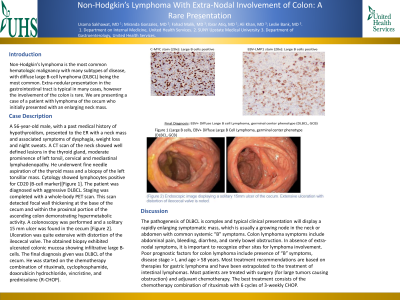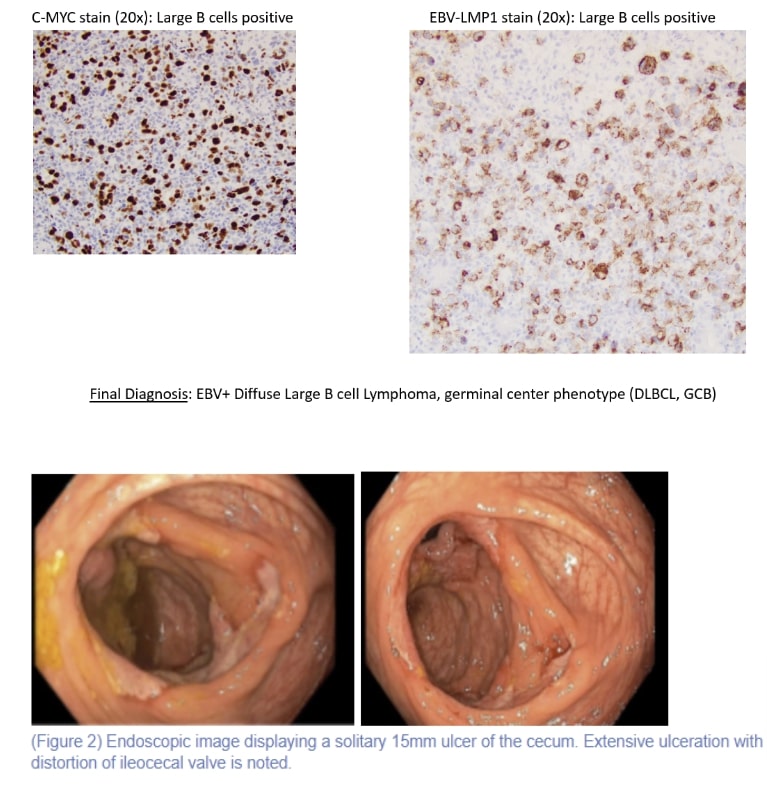Back


Poster Session A - Sunday Afternoon
Category: Colon
A0118 - Non-Hodgkin’s Lymphoma With Extra-Nodal Involvement of Colon: A Rare Presentation
Sunday, October 23, 2022
5:00 PM – 7:00 PM ET
Location: Crown Ballroom

Has Audio
.jpg)
Usama Sakhawat, MD
United Health Services Hospitals
Johnson City, NY
Presenting Author(s)
Usama Sakhawat, MD1, Miranda Gonzalez, 2, Fahad Malik, MD3, Ibrar Atiq, MD4, Ali Khan, MD5, Leslie Bank, MBChB, MD, FACG6
1United Health Services Hospitals, Johnson City, NY; 2SUNY Upstate Medical University, Syracuse, NY; 3United Health Services- Wilson Hospital, Binghamton, NY; 4United Health Services- Wilson Hospital, Johnson City, NY; 5United Health Services Hospital, Johnson City, NY; 6United Health Services, Binghamton, NY
Introduction: Non-Hodgkin’s lymphoma is the most common hematologic malignancy with many subtypes of disease, with diffuse large B-cell lymphoma (DLBCL) being the most common. Extra-nodular presentation in the gastrointestinal tract is typical in many cases, however the involvement of the colon is rare. We are presenting a case of a patient with lymphoma of the cecum who initially presented with an enlarging neck mass.
Case Description/Methods: A 56-year-old male, with a past medical history of hypothyroidism, presented to the ER with a neck mass and associated symptoms of dysphagia, weight loss and night sweats. A CT scan of the neck showed well defined lesions in the thyroid gland, moderate prominence of left tonsil, cervical and mediastinal lymphadenopathy. He underwent fine needle aspiration of the thyroid mass and a biopsy of the left tonsillar mass. Cytology showed lymphocytes positive for CD20 (B-cell marker)[Figure 1]. The patient was diagnosed with aggressive DLBCL. Staging was completed with a whole-body PET scan. This scan detected focal wall thickening at the base of the cecum and within the proximal portion of the ascending colon demonstrating hypermetabolic activity. A colonoscopy was performed and a solitary 15 mm ulcer was found in the cecum [Figure 2]. Ulceration was quite extensive with distortion of the ileocecal wall. The obtained biopsy exhibited ulcerated colonic mucosa showing infiltrative large B-cells. The final diagnosis given was DLBCL of the cecum. He was started on the chemotherapy combination of rituximab, cyclophosphamide, doxorubicin hydrochloride, vincristine, and prednisolone (R-CHOP).
Discussion: The pathogenesis of DLBCL is complex and typical clinical presentation will display a rapidly enlarging symptomatic mass, which is usually a growing node in the neck or abdomen with common systemic “B” symptoms. Colon lymphoma symptoms include abdominal pain, bleeding, diarrhea, and rarely bowel obstruction. In absence of extra-nodal symptoms, it is important to recognize other sites for lymphoma involvement. Poor prognostic factors for colon lymphoma include presence of “B” symptoms, disease stage > I, and age > 58 years. Most treatment recommendations are based on therapies for gastric lymphoma and have been extrapolated to the treatment of intestinal lymphomas. Most patients are treated with surgery (for large tumors causing obstruction) and adjuvant chemotherapy. The best treatment consists of the chemotherapy combination of rituximab with 6 cycles of 3-weekly CHOP.

Disclosures:
Usama Sakhawat, MD1, Miranda Gonzalez, 2, Fahad Malik, MD3, Ibrar Atiq, MD4, Ali Khan, MD5, Leslie Bank, MBChB, MD, FACG6. A0118 - Non-Hodgkin’s Lymphoma With Extra-Nodal Involvement of Colon: A Rare Presentation, ACG 2022 Annual Scientific Meeting Abstracts. Charlotte, NC: American College of Gastroenterology.
1United Health Services Hospitals, Johnson City, NY; 2SUNY Upstate Medical University, Syracuse, NY; 3United Health Services- Wilson Hospital, Binghamton, NY; 4United Health Services- Wilson Hospital, Johnson City, NY; 5United Health Services Hospital, Johnson City, NY; 6United Health Services, Binghamton, NY
Introduction: Non-Hodgkin’s lymphoma is the most common hematologic malignancy with many subtypes of disease, with diffuse large B-cell lymphoma (DLBCL) being the most common. Extra-nodular presentation in the gastrointestinal tract is typical in many cases, however the involvement of the colon is rare. We are presenting a case of a patient with lymphoma of the cecum who initially presented with an enlarging neck mass.
Case Description/Methods: A 56-year-old male, with a past medical history of hypothyroidism, presented to the ER with a neck mass and associated symptoms of dysphagia, weight loss and night sweats. A CT scan of the neck showed well defined lesions in the thyroid gland, moderate prominence of left tonsil, cervical and mediastinal lymphadenopathy. He underwent fine needle aspiration of the thyroid mass and a biopsy of the left tonsillar mass. Cytology showed lymphocytes positive for CD20 (B-cell marker)[Figure 1]. The patient was diagnosed with aggressive DLBCL. Staging was completed with a whole-body PET scan. This scan detected focal wall thickening at the base of the cecum and within the proximal portion of the ascending colon demonstrating hypermetabolic activity. A colonoscopy was performed and a solitary 15 mm ulcer was found in the cecum [Figure 2]. Ulceration was quite extensive with distortion of the ileocecal wall. The obtained biopsy exhibited ulcerated colonic mucosa showing infiltrative large B-cells. The final diagnosis given was DLBCL of the cecum. He was started on the chemotherapy combination of rituximab, cyclophosphamide, doxorubicin hydrochloride, vincristine, and prednisolone (R-CHOP).
Discussion: The pathogenesis of DLBCL is complex and typical clinical presentation will display a rapidly enlarging symptomatic mass, which is usually a growing node in the neck or abdomen with common systemic “B” symptoms. Colon lymphoma symptoms include abdominal pain, bleeding, diarrhea, and rarely bowel obstruction. In absence of extra-nodal symptoms, it is important to recognize other sites for lymphoma involvement. Poor prognostic factors for colon lymphoma include presence of “B” symptoms, disease stage > I, and age > 58 years. Most treatment recommendations are based on therapies for gastric lymphoma and have been extrapolated to the treatment of intestinal lymphomas. Most patients are treated with surgery (for large tumors causing obstruction) and adjuvant chemotherapy. The best treatment consists of the chemotherapy combination of rituximab with 6 cycles of 3-weekly CHOP.

Figure: Figure 1 (Large B cells, EBV+ Diffuse Large B Cell Lymphoma, germinal center phenotype (DLBCL, GCB)
Figure 2 (Endosocopic image displaying a solitary 15 mm ulcer of the cecum. Extensive ulceration with distortion of ileocecal valve is noted).
Figure 2 (Endosocopic image displaying a solitary 15 mm ulcer of the cecum. Extensive ulceration with distortion of ileocecal valve is noted).
Disclosures:
Usama Sakhawat indicated no relevant financial relationships.
Miranda Gonzalez indicated no relevant financial relationships.
Fahad Malik indicated no relevant financial relationships.
Ibrar Atiq indicated no relevant financial relationships.
Ali Khan indicated no relevant financial relationships.
Leslie Bank indicated no relevant financial relationships.
Usama Sakhawat, MD1, Miranda Gonzalez, 2, Fahad Malik, MD3, Ibrar Atiq, MD4, Ali Khan, MD5, Leslie Bank, MBChB, MD, FACG6. A0118 - Non-Hodgkin’s Lymphoma With Extra-Nodal Involvement of Colon: A Rare Presentation, ACG 2022 Annual Scientific Meeting Abstracts. Charlotte, NC: American College of Gastroenterology.
